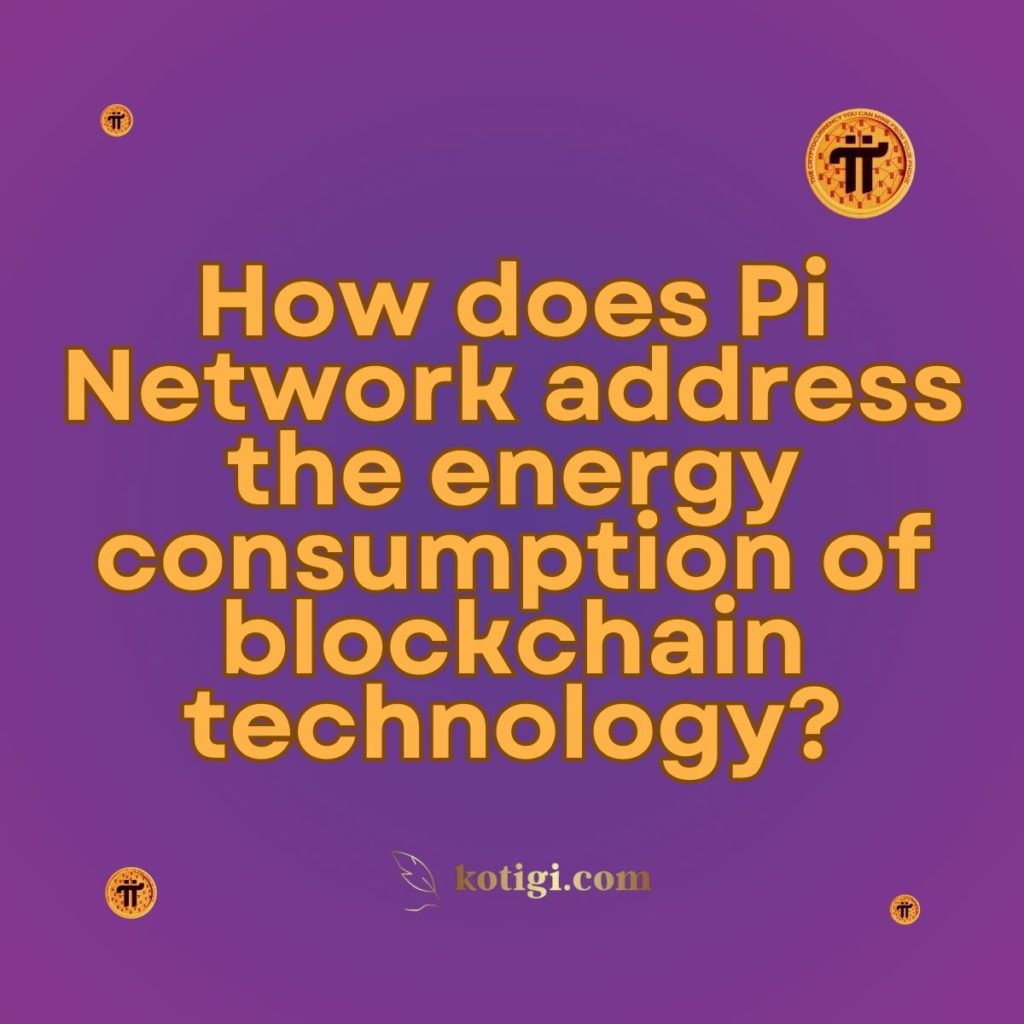
How does Pi Network address the energy consumption of blockchain technology?
Pi Network tackles the high energy consumption of blockchain by utilizing a unique consensus mechanism, the Federated Byzantine Agreement (FBA), which does not rely on energy-intensive mining. This allows users to mine Pi coins on their smartphones with minimal battery and data usage, making Pi Network an eco-friendly alternative in the world of cryptocurrencies.
Table comparing Pi energy consumption to Bitcoin, Ethereum and Cardano
Here’s a table comparing how Pi Network addresses energy consumption of blockchain technology in relation to other cryptocurrencies:
| Aspect | Pi Network | Bitcoin | Ethereum (PoW) | Ethereum (PoS) | Cardano |
|---|---|---|---|---|---|
| Consensus Mechanism | Federated Byzantine Agreement (FBA) | Proof of Work (PoW) | Proof of Work (PoW) | Proof of Stake (PoS) | Proof of Stake (PoS) |
| Energy Consumption | Minimal; mobile mining with low resource use | High; requires significant computational power | High; similar to Bitcoin | Reduced; but still requires some energy | Low; efficient validation process |
| Mining Process | Smartphone-based, easy and energy-efficient | Hardware-intensive, complex computations | Hardware-intensive, similar to Bitcoin | Validator-based, relies on staked coins | Validator-based, efficient and low-impact |
| Environmental Impact | Eco-friendly, aligns with sustainability goals | High environmental footprint | High environmental footprint | Lower environmental footprint | Lower environmental footprint |
| Accessibility | Open to all users with smartphones | Requires specialized mining equipment | Requires specialized mining equipment | Requires staking, but less hardware intensive | Requires staking, more accessible than PoW |
| User Engagement | Strong community involvement | Limited to miners | Limited to miners | Broader engagement through staking | Strong community through staking |
| Future Sustainability | Committed to ongoing sustainability initiatives | Faces criticism for environmental impact | Moving toward sustainability with PoS | A step toward sustainability but still evolving | Focus on sustainability and eco-friendly practices |
Introduction
Blockchain technology has revolutionized the financial landscape, yet it faces criticism for its significant environmental impact due to high energy consumption. Major cryptocurrencies like Bitcoin and Ethereum have come under scrutiny for their reliance on energy-intensive consensus mechanisms. In contrast, Pi Network employs a unique approach that minimizes energy consumption while ensuring a secure and decentralized network.
This article explores the innovative ways in which Pi Network addresses energy consumption and its commitment to sustainability in the blockchain space.
The Energy Problem in Blockchain Technology
Why Does Blockchain Consume So Much Energy?
The energy consumption of blockchain primarily stems from its consensus mechanisms, particularly proof-of-work (PoW) mining.
- Proof of Work (PoW) Basics
PoW requires miners to solve complex mathematical puzzles, leading to high energy demands. - Impact of Bitcoin Mining
Bitcoin mining consumes more electricity annually than entire countries, raising awareness about blockchain’s environmental impact. - Growing Environmental Concerns
As awareness of climate change increases, the energy consumption of cryptocurrencies becomes a focal point for criticism and calls for sustainable solutions.
Ethereum’s Transition to Proof of Stake (PoS)
Ethereum has made strides toward reducing energy consumption by transitioning from PoW to proof-of-stake (PoS).
- Mechanism of PoS
In PoS, validators are chosen based on their cryptocurrency holdings, reducing the need for energy-intensive computations. - Challenges of PoS
While PoS is more energy-efficient, it faces challenges related to centralization risks and security. - Overall Impact on Energy Consumption
The transition to PoS represents a significant shift towards more sustainable blockchain practices.
Pi Network’s Low-Energy Solution
Federated Byzantine Agreement (FBA)
Pi Network utilizes the Federated Byzantine Agreement (FBA) consensus mechanism to minimize energy consumption significantly.
- Energy Efficiency of FBA
FBA allows nodes to reach consensus without engaging in energy-intensive mining. - Consensus Without Mining
This innovative model facilitates secure transaction validation while keeping energy usage low. - Trust Circles Concept
Users can create “trust circles,” enhancing security without wasting resources.
How Does Pi Mining Work?
Mining Pi coins is accessible and energy-efficient compared to traditional mining methods.
- User-Friendly Mining Process
Users simply tap the “mine” button daily, allowing for effortless participation. - Minimal Energy Usage
The app consumes very little battery and data, addressing energy concerns while promoting user engagement. - No Need for Specialized Hardware
Pi mining can be performed on any smartphone, eliminating barriers to entry.
Pi Network’s Commitment to Sustainability
Eco-Friendly Design
Pi Network is designed with sustainability as a core principle.
- Decentralized Without Waste
The network maintains decentralization without the energy waste typical of PoW systems. - Green Blockchain Initiatives
Pi Network focuses on minimizing its environmental footprint, aligning with global sustainability goals. - Inclusive and Accessible
By lowering barriers to entry, Pi Network encourages broad participation without environmental harm.
Future Sustainability Initiatives
As Pi Network evolves, its commitment to sustainability remains strong.
- Sustainable Growth Strategies
The network plans to refine its energy-efficient mechanisms as user activity increases. - Collaboration with Green Initiatives
Pi Network seeks partnerships with organizations focused on sustainability. - Innovations in Energy Efficiency
Ongoing research aims to further reduce energy impact as the network matures.
The Broader Impact of Energy-Efficient Blockchains
Setting a New Standard
Pi Network’s focus on energy efficiency could inspire changes across the blockchain industry.
- Encouraging Eco-Friendly Practices
Pi Network’s model may prompt other projects to reconsider their consensus mechanisms. - Mainstream Adoption of Sustainable Solutions
As consumers become more eco-conscious, energy-efficient projects like Pi Network may see increased adoption. - Regulatory Compliance
By prioritizing sustainability, Pi Network positions itself favorably for future regulations.
Market Response to Eco-Friendly Blockchains
- Consumer Preferences
As awareness of environmental issues grows, consumers may prefer cryptocurrencies that prioritize sustainability. - Investor Interest
Investors may increasingly look for projects that prioritize energy efficiency. - Industry Trends
The trend towards energy-efficient blockchains may reshape the industry landscape.
How Pi Network Compares to Other Cryptocurrencies
Bitcoin
Bitcoin’s energy-intensive PoW model contrasts sharply with Pi Network’s approach.
- Energy Consumption Comparison
Bitcoin mining requires vast amounts of energy, while Pi mining can be done on everyday devices. - Environmental Footprint
Pi Network’s eco-friendly design positions it as a greener alternative. - Barriers to Entry
Pi Network lowers barriers to participation, making it more accessible for users concerned about environmental impact.
Ethereum
Ethereum’s transition to PoS represents progress, but it still requires energy for network validation.
- Energy Use in PoS
While PoS is less energy-intensive, it still demands ongoing energy for validators. - Comparison with Pi Network
Pi Network’s mobile-first, low-energy mining process is significantly more accessible and efficient. - Adoption of Sustainable Practices
Pi Network could influence other cryptocurrencies to adopt more sustainable models.
Cardano
Cardano operates on PoS, making it a more sustainable option compared to PoW networks.
- Energy Efficiency of Cardano
Cardano offers lower energy consumption, but Pi Network stands out with its mobile mining. - User Engagement
Pi Network promotes greater user engagement through its accessible mining model. - Future of Energy-Efficient Blockchains
Both projects contribute to the trend of adopting energy-efficient practices.
The Role of Community in Pi Network
Community Engagement
The success of Pi Network relies heavily on its community of users.
- User Participation
Community members actively engage in the mining process, helping to grow the network. - Feedback Mechanisms
Pi Network values user feedback, incorporating suggestions to enhance the platform. - Educational Initiatives
The network provides resources to educate users about sustainable practices and blockchain technology.
Building Trust
Trust is fundamental to the success of any decentralized network.
- Transparency
Pi Network prioritizes transparency in its operations and decision-making processes. - Trust Circles
The concept of trust circles fosters a sense of community and collaboration among users. - Security Measures
Ongoing efforts to enhance security help build confidence in the network.
Challenges Ahead for Pi Network
Regulatory Challenges
Navigating the regulatory landscape is a crucial aspect of Pi Network’s future.
- Compliance Requirements
As regulations evolve, Pi Network must ensure compliance with local and international laws. - Adaptability
The network’s ability to adapt to changing regulations will be essential for long-term success. - Potential Risks
Regulatory changes could pose risks, but proactive measures can mitigate these challenges.
Technological Hurdles
As Pi Network grows, it must address potential technological challenges.
- Scalability
Ensuring the network can handle increased user activity is vital for its success. - Security Concerns
Ongoing security assessments will be necessary to protect user data and assets. - Innovation
Continuous innovation will be crucial to maintaining a competitive edge in the blockchain space.
Conclusion
Pi Network addresses the energy consumption challenges faced by traditional blockchain networks by employing the Federated Byzantine Agreement (FBA) consensus mechanism. This innovative approach eliminates the need for energy-intensive mining, allowing users to mine Pi coins directly from their smartphones with minimal battery and data usage.
By prioritizing sustainability and energy efficiency, Pi Network sets a new standard in the blockchain industry, aligning with the growing demand for eco-conscious solutions. As the platform continues to grow and evolve, it is well-positioned to demonstrate how blockchain technology can balance decentralization, security, and sustainability.
Key Takeaways
- Pi Network employs the Federated Byzantine Agreement (FBA) consensus mechanism to minimize energy consumption.
- Mining Pi coins is energy-efficient and can be done on smartphones without significant battery drain or data usage.
- The network’s eco-friendly design aligns with global sustainability goals, setting it apart from traditional blockchain networks.
- Pi Network’s commitment to minimal energy use positions it favorably in an increasingly eco-conscious world.
- As Pi Network evolves, it may inspire other blockchain projects to adopt more sustainable practices.





